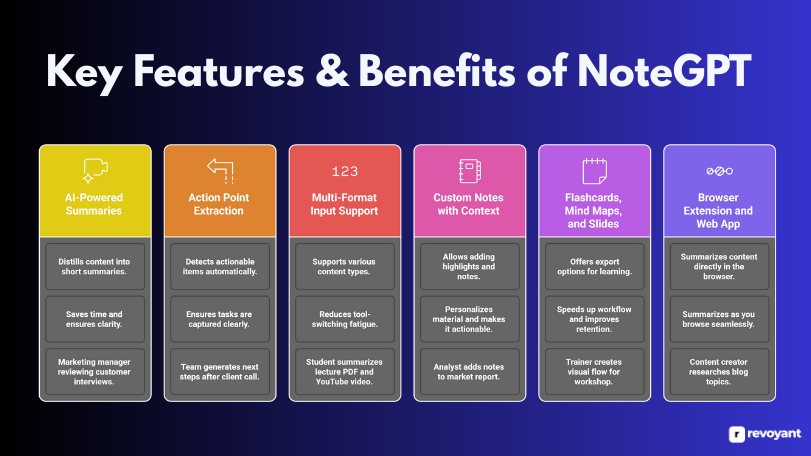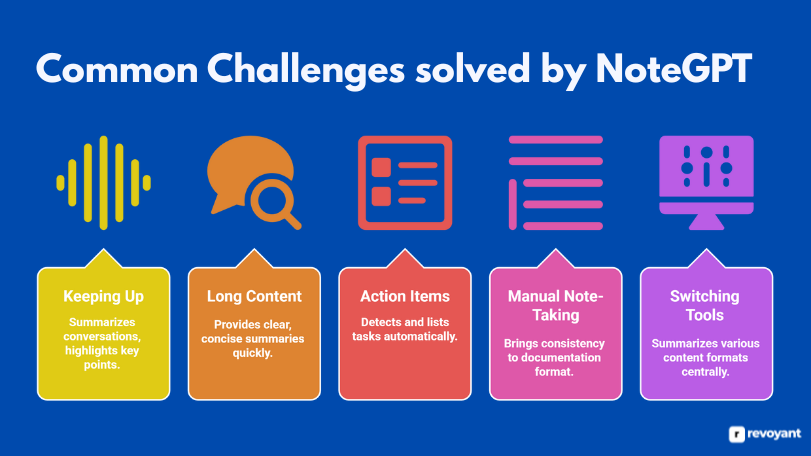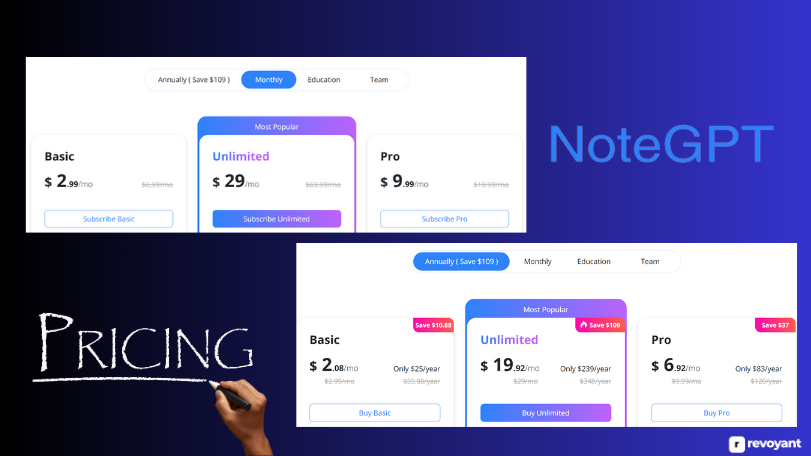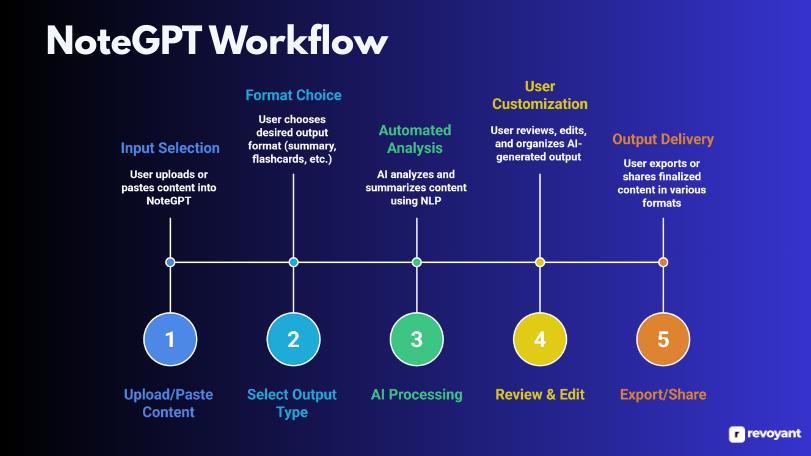⚡ Why This Blog Matters
Meeting notes can be messy and time-consuming—but NoteGPT condenses live discussions into concise, actionable summaries in just seconds.
🧠 What You’ll Learn Here
Learn how NoteGPT records audio or integrates with your favorite tools, generates structured summaries and key takeaways, tags action items, and sends ready-to-share notes via email or Slack.
🎯 Who Should Read This
Ideal for team leads, project managers, startup founders, and busy professionals who want clear, shareable meeting summaries without manual effort.
Meetings, lectures, webinars, research articles—information is everywhere, and it rarely arrives in a clean, organized format. That’s where tools like NoteGPT come in. Whether you’re a student trying to make sense of complex lectures, a professional juggling back-to-back calls, or someone simply tired of messy notes, NoteGPT offers a smart way to turn content into clear summaries and next steps.
This blog walks you through how NoteGPT works, who it’s best suited for, its core features, and how it can fit into your daily workflow. By the end, you’ll know exactly whether this tool can save you time and help you capture what truly matters.
What You’ll Learn About NoteGPT
This blog is a complete guide for anyone exploring NoteGPT or similar tools. Here’s what you’ll find:
- Discover how NoteGPT transforms unstructured content into clear summaries and action points.
- Learn who can benefit most from using NoteGPT in daily workflows.
- Explore the key features that make NoteGPT efficient and easy to use.
- Understand the pricing plans and which option fits your usage needs.
- Compare NoteGPT with top alternatives based on features and value.
What is NoteGPT and How Does It Work?
NoteGPT is a smart assistant built to make sense of scattered content. Whether you’re watching a long video, reviewing an audio recording, or reading through a dense article, it helps turn the chaos into clear summaries and simple notes.
Unlike typical note-taking apps, NoteGPT works across formats—text, audio, video, and even full web pages. You can use it to extract main ideas, highlight important topics, and capture key tasks or action points—all in a few clicks.
This tool is especially useful for people who want to save time without missing important details. It can also help you turn what you’ve learned into flashcards, quick visual diagrams, or even a slideshow for easier sharing.
With browser access and a Chrome extension, you can start summarizing content as you browse. It works in the background, letting you focus on what matters: understanding and applying information quickly.
Who Should Use NoteGPT? (Students, Teams, Creators & More)
NoteGPT is built to support people who consume, create, or manage content across different formats. Whether you’re dealing with meetings, videos, documents, or long articles, this tool can simplify the way you process information and extract value from it.
🎓 Students & Researchers
Turn long lectures, PDFs, and academic videos into simple summaries and flashcards.
- Summarize lectures & readings
- Create flashcards for study
- Extract research highlights
💼 Remote Workers
Summarize meetings and capture key takeaways without rewinding recordings.
- Auto-summarize video calls
- Track tasks & follow-ups
- Save time on documentation
📝 Creators & Marketers
Break down interviews, webinars, and videos into outlines and repurposable content.
- Extract hooks & insights
- Plan content faster
- Turn raw ideas into drafts
📊 Team Leads & PMs
Stay organized across sprints, meetings, and strategy calls with smart recaps.
- Summarize planning sessions
- Document project updates
- Capture user feedback
🚀 Solo Founders
Keep ideas, learnings, and customer conversations structured without extra effort.
- Summarize calls & videos
- Organize notes by topic
- Convert ideas into action plans
Students & Academic Researchers: Turn Content into Smart Study Tools
For students juggling lectures, assignments, and readings, NoteGPT takes the pressure off. It summarizes video tutorials, academic articles, and study material into crisp notes and quick-reference flashcards. Instead of spending hours rewatching or rereading, students can focus on understanding and retaining concepts.
Researchers also benefit by turning lengthy papers or reports into condensed insights that can be reviewed, referenced, or shared more easily.
Use Cases:
- Turn recorded lectures into smart notes for revision
- Summarize journal articles or PDF textbooks
- Create flashcards for quick study sessions
- Capture takeaways from webinars and conferences
Remote Workers: Summarize Meetings & Save Time
When meetings stack up, it’s easy to forget decisions, next steps, or who said what. NoteGPT makes post-meeting chaos manageable by summarizing calls into clear, structured overviews. Whether it’s a client catch-up, internal sync, or strategy session, professionals can keep track without rewinding recordings or typing out notes manually.
Use Cases:
- Automatically summarize Zoom, Google Meet, or Teams calls
- Generate action items for team members
- Review missed meetings in minutes
- Save time on follow-up documentation
Content Creators & Marketers: Repurpose Content with Ease
Content creators often start with raw material—podcasts, interviews, webinars—that need to be turned into something publishable. NoteGPT simplifies this by extracting highlights, insights, and quotable lines from long-form content. It becomes easier to plan blogs, social posts, and campaigns based on actual conversations.
Use Cases:
- Break down video/audio interviews into blog outlines
- Identify hooks, talking points, or soundbites
- Turn webinars into guides or thought-leadership content
- Build content calendars from repurposed insights
Product Managers & Team Leaders: Capture Every Detail from Planning Calls
Managing cross-functional teams involves dozens of discussions, updates, and planning calls. NoteGPT helps product and project managers stay organized by automatically capturing meeting outcomes. This ensures clarity on next steps, ownership, and timelines, without relying on memory or manual tracking.
Use Cases:
- Summarize sprint retrospectives or planning meetings
- Document decisions and milestones
- Create shareable summaries for stakeholders
- Capture user feedback from discovery calls
Entrepreneurs & Solo Operators: Organize Ideas, Research & Conversations
For founders or freelancers running the show alone, staying organized is key. NoteGPT keeps your ideas, research, and conversations structured so you can focus on growth. From turning YouTube tutorials into learnable chunks to organizing customer support calls into task lists, it saves time while keeping you on track.
Use Cases:
- Extract insights from educational videos or market research
- Keep track of investor or partner meetings
- Turn brainstorming voice notes into business ideas
- Organize daily learnings and tasks into one view
Top Features of NoteGPT That Save Time & Boost Clarity
NoteGPT goes beyond simple transcription. It’s designed as a smart assistant for capturing, processing, and turning information into usable knowledge, saving time while improving clarity.

Below is a deeper look into each core feature and the value it brings to daily tasks.
AI-Powered Summaries
What it does:
NoteGPT uses advanced AI to scan through long-form content, like YouTube videos, audio files, articles, or transcripts, and distills them into short, structured summaries.
Why it matters:
Instead of spending an hour watching a video or reading a lengthy report, users can get the main points in seconds. This is especially helpful for busy professionals, students, or researchers who want the highlights without wasting time. It also ensures nothing important is missed or misinterpreted, as the summary focuses on the intent and context behind the content.
Real use case:
A marketing manager reviewing multiple customer interviews can get key takeaways without playing back each recording.
Action Point Extraction
What it does:
NoteGPT automatically detects actionable items, such as tasks, follow-ups, or decisions, discussed in a piece of content and lists them clearly.
Why it matters:
Meetings often end without clarity on what needs to happen next. This feature ensures tasks are captured and ready for assignment. It’s especially valuable for remote teams or managers juggling multiple projects where follow-through is critical.
Real use case:
After a client call, the tool generates a list of next steps, which the team can immediately plug into their task management system.
Multi-Format Input Support
What it does:
NoteGPT supports a wide range of content types, including YouTube links, PDFs, MP3/MP4 files, text pasted from articles, or entire web pages.
Why it matters:
You don’t have to use different tools for different content formats. Whether it’s a recorded webinar, a lecture, a sales call, or a research document, NoteGPT can process them all within one dashboard, saving time and reducing tool-switching fatigue.
Real use case:
A student uploads a lecture PDF, pastes in notes from an online blog, and adds a YouTube explainer—then summarizes all of them in one go.
Custom Notes with Context
What it does:
Users can interact with the summary by adding highlights, personal notes, and context directly within the NoteGPT workspace.
Why it matters:
It’s not just about consuming the content—it’s about engaging with it. Being able to edit or annotate the AI output helps you personalize the material and make it actionable. Whether you’re preparing to share it with your team or using it to study, this flexibility makes it more effective.
Real use case:
An analyst summarizes a market report and adds personal notes for each key insight before sharing it with their leadership team.
Flashcards, Mind Maps, and Slides
What it does:
NoteGPT offers export options that turn content into flashcards for learning, mind maps for visual breakdowns, and slides for presentations.
Why it matters:
Instead of having to create study tools or decks from scratch, the platform does the heavy lifting. This is ideal for educators, students, and professionals preparing materials for others. It speeds up workflow while improving retention and delivery.
Real use case:
A trainer uses the mind map output to create a visual flow of a process and generates slides for the next day’s workshop, without opening PowerPoint.
Browser Extension and Web App
What it does:
NoteGPT provides a Chrome extension that lets users summarize content from web pages or transcripts directly in the browser, without switching tabs.
Why it matters:
You can summarize as you browse, which is perfect for research, content curation, or learning on the go. It eliminates the need for manual copying and pasting and fits seamlessly into your existing habits.
Real use case:
A content creator researching blog topics highlights key insights on an article and summarizes them directly via the extension—turning research into an outline in minutes.
Common Problems NoteGPT Helps You Eliminate
NoteGPT helps solve some of the most common productivity and workflow problems people face when dealing with content from meetings, classes, or digital resources. Here’s how it helps tackle each issue head-on.

Meetings Move Fast—Let NoteGPT Capture the Key Moments
Taking notes while trying to participate in a discussion is difficult. You’re either too focused on capturing every word or too engaged to write anything down. This often leads to gaps in documentation or forgotten points.
NoteGPT addresses this by automatically summarizing the conversation after the meeting. It highlights key decisions, questions, and follow-ups—freeing you to focus fully during the call without worrying about missing something.
Speed Through Long Videos & Articles with Smart Summaries
Whether it’s a one-hour YouTube lecture, a podcast episode, or a detailed blog post, going through long content just to find a few useful insights can be time-consuming.
NoteGPT simplifies this by giving you a clear, concise summary of the main ideas within minutes. You no longer need to scrub through timestamps or scroll endlessly to understand the core message.
Capture Every Task with Auto-Extracted Action Points
After a team call or brainstorming session, tasks are often scattered across emails, chat apps, or people’s memories. Without a clear system to capture and track these, it’s easy for important items to be forgotten.
NoteGPT automatically detects and lists out tasks or action items discussed in the meeting, helping you assign, track, and follow through—without needing a separate tool.
Replace Manual Notes with Consistent AI Summaries
Everyone has a different and smarter note-taking style, and some people may not take notes at all. The result? Important points get missed, and follow-ups become vague.
NoteGPT brings consistency to your documentation. Whether it’s the same team handling meetings or different people each time, summaries follow a clear format, reducing confusion and keeping everyone on the same page.
Summarize Everything in One App—No Tool Switching Needed
If you’re dealing with videos, PDFs, meeting audio, and web content, you might need multiple tools to handle each format. That leads to a fragmented workflow and duplicated effort.
NoteGPT allows you to drop in nearly any type of content—from YouTube videos and voice recordings to PDFs and web links—and get a structured summary from one dashboard. This keeps your workflow simple and centralized.
NoteGPT Pricing Plans: Free, Basic, Pro & Annual Options
NoteGPT offers a range of subscription plans to cater to different user needs. Whether you’re a student, educator, professional, or content creator, there’s a plan designed to enhance your productivity.

Free Plan
- Quota: 15 AI requests per month
- Features: Access to core summarization tools, including YouTube, PDF, and text summarizers
- Ideal for: New users exploring the platform’s capabilities
Basic Plan
- Price: $2.99/month
- Quota: 200 AI requests per month
- Features: Enhanced access to summarization tools and faster processing
- Ideal for: Students and individuals with moderate usage needs
Pro Plan
- Price: $9.99/month
- Quota: 1,000 AI requests per month
- Features: Full access to all AI tools, including advanced features like AI flashcard maker, mind map generator, and priority support
- Ideal for: Professionals and educators requiring extensive use of AI tools
Annual Subscription
- Discount: Save 30% compared to monthly plans
- Auto-Renewal: Annual subscriptions do not automatically renew, providing flexibility and control
- Ideal for: Users committed to long-term use and looking for cost savings
Quota Usage: NoteGPT operates on a quota system, where each AI service consumes a certain number of quotas. For instance, summarizing a YouTube video or a PDF document typically uses one quota per 10,000 words. Different features consume varying amounts of quotas based on computational requirements.
Subscription Management: Users can easily upgrade, downgrade, or cancel their subscriptions through the “Subscriptions” menu in the workspace. Monthly subscriptions auto-renew, while annual subscriptions do not, offering flexibility based on user preference.
For the most current and detailed information on NoteGPT’s pricing and features, please visit their official pricing page: NoteGPT – Pricing.
How to Use NoteGPT to Summarize Content in Seconds
NoteGPT is built to simplify the way you capture, process, and summarize content across various formats. Whether it’s a meeting recording, a YouTube video, or a long article, the tool follows a simple workflow that anyone can get started with in minutes.

1. Upload or Paste the Content
Start by either uploading a file (like a PDF or MP4) or pasting a URL—such as a YouTube link, blog post, or online article. You can also type or paste raw text directly into the editor.
Supported inputs include:
- YouTube videos (via link)
- Audio/video files (MP3, MP4)
- PDF documents
- Web articles and blog URLs
- Text content (typed or pasted manually)
2. Select the Type of Output You Want
Once your content is added, choose what you need from the tool:
- A quick summary
- Action items or bullet points
- Flashcards for study
- Mind map view for concept mapping
- Slide-style presentation format
Each option helps you digest the material in a way that suits your workflow—whether you’re reviewing, learning, or presenting.
3. Let the AI Process the Content
Once you hit “summarize” or select your desired output format, NoteGPT’s AI engine begins working instantly. The system analyzes the structure, length, and context of your content—whether it’s a lecture, a podcast, or a research paper.
It uses natural language processing (NLP) to understand tone, identify important concepts, and break down the information into structured, digestible segments.
The processing is not just about shortening the content—it’s about identifying what matters most. For example:
- In a meeting recording, it picks out decisions, questions, and follow-ups.
- A video identifies the main topics covered.
- A document captures key arguments or summary paragraphs.
This step takes only a few seconds, depending on the content length, and is fully automated—no manual effort needed.
4. Review, Edit, and Save
After the AI presents its summary or structured output, you have the option to fine-tune it. This is where NoteGPT stands apart—it allows full control over the final version.
You can:
- Highlight or delete lines
- Add your own comments or context
- Rephrase content if needed
- Organize outputs into folders for future reference
This makes NoteGPT flexible. You’re not locked into the AI output—you can make it your own. Whether you’re preparing notes for study, a team update, or a client report, the tool adjusts to your preferences.
5. Export or Share
Once your content is finalized, NoteGPT offers multiple ways to use or distribute it.
You can:
- Download the output as a text file, PDF, or formatted slides
- Create flashcards for spaced repetition learning
- Generate mind maps for visual review
- Share links or files with teammates or collaborators
- Use the Chrome extension to push content directly to the platform for fast access later
This flexibility means you can turn summaries into learning tools, meeting recaps into tasks, and content ideas into ready-to-use material—all in one place.
Best Alternatives to NoteGPT for Summarization & Meeting Notes
Below are some strong alternatives to NoteGPT, each offering different strengths for meeting transcription, summarization, or learning use cases.
| Tool | Best For | Key Features | Pricing |
|---|---|---|---|
| Fireflies.ai | Automated meeting transcription | Real-time summaries, CRM sync, collaboration tools | Free plan available; Paid plans start at $10/user/month |
| Otter.ai | Education and business notes | Live transcription, speaker tags, searchable notes | Free plan available; Pro plan at $8.33/user/month |
| Supernormal | Async team updates | AI-generated summaries, task lists, Notion/Slack exports | Free plan available; Pro plan at $10/user/month |
| Sembly AI | Professional teams and consultants | Meeting insights, smart agenda builder, integrations | Free plan available; Paid plans start at $10/user/month |
| Avoma | Sales and customer success teams | AI coaching, deal tracking, conversation insights | Paid plans start at $19/user/month |
Final Thoughts on Using NoteGPT
NoteGPT offers a practical solution for anyone who deals with a high volume of content, whether it’s meetings, lectures, or long-form media. It simplifies the way you capture and summarize information, helping you focus on what matters without losing time or context.
From automatic meeting recaps and action points to flashcards and presentation-ready slides, the tool fits a variety of use cases. Its flexible pricing, multi-format support, and AI-powered features make it a strong option for individuals, teams, and educators looking to stay organized and efficient.
If you’re looking for a smarter way to turn information into usable insights, NoteGPT is worth exploring. Try the free version to see how it fits your workflow—and upgrade as your needs grow.
NoteGPT FAQ: Everything You Need to Know
What is NoteGPT?
NoteGPT is a tool that transforms messy meeting notes into clear summaries and actionable points. It helps organize information quickly and effectively.
How does NoteGPT improve meeting productivity?
It saves time by summarizing long, unstructured notes into concise action points. This makes follow-ups easier and keeps teams focused on priorities.
Can NoteGPT handle different types of meeting notes?
Yes, it works with various formats, whether handwritten or digital, turning them into structured summaries for easy understanding.
Who can benefit from using NoteGPT?
Professionals across industries can use it to streamline communication after meetings—managers, team leaders, or anyone handling detailed discussions will find it helpful.



